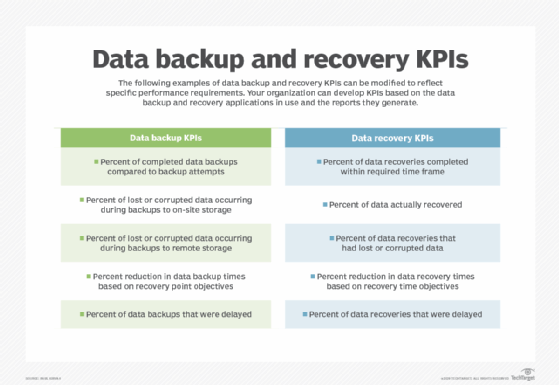
Fotolia
Develop a backup KPI to improve performance
Key performance indicators help ensure that IT teams meet the needs of the business. A backup KPI demonstrates effective data protection to both customers and management.
Organizations traditionally perform data backup and recovery according to specific procedures. As IT departments mature, however, they must examine their existing approaches to address performance.
Organizations should identify a specific analytical metric -- the key performance indicator (KPI) -- whose inclusion in the data backup and recovery processes can improve overall results. More importantly, the use of a backup KPI can increase senior management's awareness and acceptance of data backup and recovery activities.
Key performance indicators
A key performance indicator measures how well something performs against a set of metrics. Its goal here is to help an IT department define and evaluate success in performing data backup and recovery activities. By establishing performance goals, it becomes easier to monitor the progress of specific activities.
IT teams can identify this KPI by answering the question: "What is really important to the organization in terms of data backup and recovery performance?" An organization can monitor the backup KPI for compliance by examining statistical data generated by the backup systems, for example.
Elements such as a performance benchmark, performance target and time frame all help create a measurable objective for a KPI. For example, "Reduce average data backup times by 15% in 2020" would be a relevant backup KPI. The organization can then monitor performance data supplied by the data backup system and compare it to the KPI requirements.

Business motivations for KPIs
Organizations often use KPIs to determine the value of difficult-to-measure activities. These can include the benefits of leadership development, customer engagement, customer service and customer satisfaction. In backup and recovery, KPIs measure the performance of an IT department's backup and recovery activities against specific and measurable goals.
KPIs are also useful from an audit perspective. Each KPI can be considered a control, which can then be examined using an audit methodology. Results of KPI audits can be important evidence of the organization's commitment to secure data backup and recovery. A backup KPI might be an important metric for existing and potential customers, and another way to bolster the organization's reputation.
Identifying the backup KPI
IT departments typically have performance goals for data backup and recovery. These can be transformed into KPIs. Key requirements for identifying KPIs include the following:
- Have a predefined technology process.
- Set requirements for that technology process.
- Measure the results of the process and compare them with set goals.
- Investigate variances and modify processes or resources to achieve goals.
When identifying a backup KPI, the predefined technology process is data backup. The requirements are complete, secure, up-to-date backups of data. To measure and compare results to set goals, determine if the results of the data backups are consistent with the performance metrics set by the organization. Lastly, investigate what the IT team needs to achieve the desired backup performance and modify resources and processes accordingly.
Many organizations use SMART criteria to formulate a backup KPI. This means the metric has a specific purpose for the business or IT department; is measurable to obtain a value of the KPI; has defined performance goals that are achievable; is relevant to measure and to manage; and is time-bound, which means the values and outcomes are shown for a predefined and relevant period.
Categorizing KPIs
Raw sets of data that an organization analyzes against performance metrics are called indicators. Candidates for KPIs fall into the following subcategories:
- Quantitative indicators, which can be presented as a number.
- Practical indicators that interface with existing company processes.
- Directional indicators specifying whether an organization gets better.
- Actionable indicators, which an organization can sufficiently control to bring about change.
- Financial indicators to evaluate if the system provides value compared to its cost.
Achievement of KPIs for data backup demonstrate success in backup and recovery activities. These metrics are important to CIOs and IT management and are also key controls used in the IT audit process.
Challenges of using KPIs
Managing the use of KPIs can become expensive or difficult for businesses. KPIs such as employee morale might be difficult -- or impossible -- to quantify. In addition, once an organization creates a KPI, it can become difficult to adjust to changing needs, as historical comparisons can be lost. Conversely, an organization might create a questionable KPI simply because historical data does not exist.
Organizations typically base backup KPIs on finite metrics. This makes it easier to use in data backup and recovery measurement. However, a backup KPI based only on in-house practices can create issues. It can make it difficult for an IT department to compare its performance with similar organizations. An organization might create KPIs and other benchmarks based on businesses with a similar background or business model to avoid this problem.
Faster availability of data is often a competitive issue -- and advantage -- for many organizations. Use KPIs and regular analyses of backup KPI data to ensure that an organization can maintain those important competitive advantages.
Paul Kirvan is an independent consultant, IT auditor, technical writer, editor and educator. He has more than 25 years of experience in business continuity, disaster recovery, security, enterprise risk management, telecom and IT auditing.






